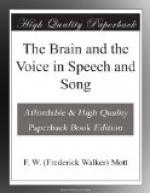Articulate language has converted the vocal instrument into the chief agent of the will, but the brain in the process of time has developed by the movements of the lips, tongue, jaw, and soft palate a kinaesthetic[A] sense of articulate speech, which has been integrated and associated in the mind with rhythmical modulated sounds conveyed to the brain by the auditory nerves. There has thus been a reciprocal simultaneity in the development of these two senses by which the mental ideas of spoken words are memorised and recalled. Had man been limited to articulate speech he could not have made the immense progress he has made in the development of complex mental processes, for language, by using written verbal symbols, has allowed, not merely the transmission of thought from one individual to another, but the thoughts of the world, past and present, are in a certain measure at the disposal of every individual. With this introduction to the subject I will pass on to give a detailed description of the instrument of the voice.
[Footnote A: Sense of movement.]
THE VOCAL INSTRUMENT
A distinction is generally made in physics between sound and noise. Noise affects our tympanic membrane as an irregular succession of shocks and we are conscious of a jarring of the auditory apparatus; whereas a musical sound is smooth and pleasant because the tympanic membrane is thrown into successive periodic vibrations to which the auditory receptor (sense organ of hearing) has been attuned. To produce musical sounds, a body must vibrate with the regularity of a pendulum, but it must be capable of imparting sharper or quicker shocks to the air than the pendulum. All musical sounds, however they are produced and by whatever means they are propagated, may be distinguished by three different qualities:
(1) Loudness, (2) Pitch, (3) Quality, timbre or klang, as the Germans call it.
Loudness depends upon the amount of energy expended in producing the sound. If I rub a tuning-fork with a well-rosined bow, I set it in vibration by the resistance offered to the rosined hair; and if while it is vibrating I again apply the bow, thus expending more energy, the note produced is louder. Repeating the action several times, the width of excursion of the prongs of the tuning-fork is increased. This I can demonstrate, not merely by the loudness of the sound which can be heard, but by sight; for if a small mirror be fixed on one of the prongs and a beam of light be cast upon the mirror, the light being again reflected on to the screen, you will see the spot of light dance up and down, and the more energetically the tuning-fork is bowed the greater is the amplitude of the oscillation of the spot of light. The duration of the time occupied is the same in traversing a longer as in traversing a shorter space, as is the case of the swinging pendulum. The vibrating prongs of the tuning-fork throw the air into vibrations which are conveyed to the ear and produce the sensation of sound. The duration of time occupied in the vibrations of the tuning-fork is therefore independent of the space passed over. The greater or less energy expended does not influence the duration of time occupied by the vibration; it only influences the amplitude of the vibration.




